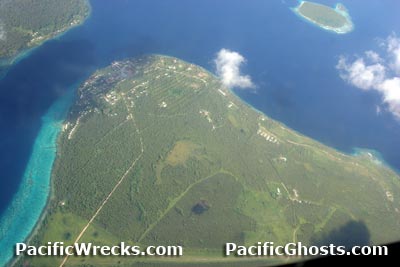|
|
|
| Missing In Action (MIA) | Prisoners Of War (POW) | Unexploded Ordnance (UXO) |
| Chronology | Locations | Aircraft | Ships | Submit Info | How You Can Help | Donate |
|
 Justin Taylan 2007 |
Location Lat 9° 4' 60S Long 159° 11' 60E Banika Island a flat and narrow island in the Russell Islands Group (Russell Islands). To the northwest is Sunlight Channel and beyond is Hai Island (Moko) and Pavuvu Island. Borders Renard Sound to the east. Prewar and during the Pacific War part of the British Solomon Islands Protectorate (BSIP). Today located in Central Province in the Solomon Islands. Wartime History On January 28, 1943 in the evening, the Japanese Navy landed 300 personnel on Banika as a diversionary action to cover the withdrawal of Japanese forces from Cape Esperance during February 1943. The Japanese had a barge relaying base at Baisen (Baizen, Maizen). The Japanese on Banika Island were the last to be evacuated during Operation Ke (January 14, 1943–February 7, 1943). On February 17, 1943 after dark, a small U.S. Army reconnaissance team lands on Banika and discovers the Japanese have withdrawn. On February 21, 1943 Task Force 62 (TF-62) "Operation Cleanslate" lands U.S. personnel on Banika and Pavuvu while U.S. planes from Guadalcanal covered the landings. The 43d Infantry Division 103d Infantry Regiment and 152d Field Artillery Battalion (105mm Howitzers tractor drawn) land at three locations: two at the mouth of Renard Sound to the east, and Wernham Cove "Yellow Beach" to the south. The landings on Banika were unopposed. The next day, the 169th Infantry Regiment landed. North Field (Banika Field, Sunlight Field) Located northwest of Sunlight Channel. After the American landing on February 21, 1943, U.S. Navy (USN) SeaBees began constructing a single runway that was eventually 4,700' 150' with extensive revetment areas around it, disused since the Pacific War. Renard Field (South Field, Yandina) American build airfield. Renard Sound Seaplane Operating Area Area between North Field and South Field, used as a seaplane operating area, in addition to the open channel to the east. During mid-1943, a ferry service connected the two parts of the island also. Wernham Cove (Yellow Beach) Located at the southern end of Banika. Code named "Yellow Beach", on February 19, 1943, Headquarters and the 1st Battalion of the 103rd Regimental Combat Team, the 43d Signal Company, the 11th Defense Battalion detachment, and 43d Division headquarters landed at this location. By the end of February, a PT-Boat base and radar station were established at this location. Hill 710 Highest elevation on the island. Burns Phillips Wharf This wharf was built before the war by Burns Phillips company. After the war, munitions, specifically artillery shells were dumped in this area. Mustard Gas Dump Banika maintained large dumps for munitions, including poison gas. Although never used in combat, the American military maintained large stockpiles of Mustard gas in artillery shells and bombs. Its presence was highly secret, but well known to men on the island. Vincent Butch Bochiaro adds: "I served in the USN on Baniki from Nov. 43 until Sept 45. I was attached to Mob 10 a hospital unit. Guarded nurses. Drove ambulances and would to hear from one who served there." Ammo dump fire October 1945 RM3c Richard A. Saylor recalled in a October 20, 1945 letter: "I was going to tell you about the ammo dump that blew up the other morning. It was about 1:30 in the morning, and the siren started blowing like mad. I had just come off an evening watch, and only just got to sleep. The while sky light up, and the ground shoot so that you could feel the tent floor vibrate. I first thought we would hall have to go fight fire. But, we didn't thou they sure cleared the men out of the bases over there on that part of the island fast. We were safe enough here, but the bad part was that there was two and a half miles of mustard gas, and other gas stored there. Just a good thing the fire didn't get it. It burned up till way after noon the same day. Jim was talking to one of the guys who fought the fire and he said he thought he was lucky to be alive. There were bullets, shrapnel and and everything but no one got burnt. He said it was as bad as any battle. Boy, glad I'm a radio man." In 1988, an Australian was demolishing these weapons. After the charge went off, there was an almond odor in the air, and he was burned on the face by mustard gas. American military was immediately dispatched to the island to deal with the possibility of more gas. In late January 2006 another mustard gas report was reported and a second team dispatched. They found nothing other than a few conventional artillery shells in a swampy area. Contribute
Information Last Updated
|
Map 1945 |
| Discussion Forum | Daily Updates | Reviews | Museums | Interviews & Oral Histories |
|